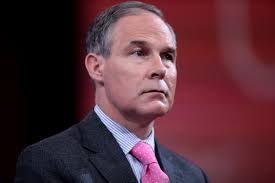By Michael B. Gerrard
 The Clean Power Plan proposed by the Environmental Protection Agency in June is the centerpiece of the Obama Administration’s efforts to fight climate change. Coal-fired power plants are by far the largest source of greenhouse gas emissions in the United States, and the EPA proposal would require the states to prepare plans to reduce those emissions.
The Clean Power Plan proposed by the Environmental Protection Agency in June is the centerpiece of the Obama Administration’s efforts to fight climate change. Coal-fired power plants are by far the largest source of greenhouse gas emissions in the United States, and the EPA proposal would require the states to prepare plans to reduce those emissions.
Members of Congress from states that mine or use a lot of coal are trying to halt this plan, and already three lawsuits have been filed against it. These lawsuits may well be dismissed as premature; ordinarily suits cannot be brought against regulations that are not yet final.
But what happens if any of these challenges is successful?
First, a word about how we got here.
Congress has not enacted or repealed a major environmental statute since 1990. We have had a quarter century of new developments in science, technology and economics, but the laws are frozen in time.
Almost all economists agree that the best way to fight climate change is through a price on carbon, either through a carbon tax or a cap and trade system. But EPA is stuck with these old regulatory tools that are very poorly suited to the problem. EPA has been forced to tie itself into pretzels to come up with programs that fit more or less within the statutory constraints, and there are several theories under which the Clean Power Plan might be legally flawed. But during this period of Congressional paralysis, the alternative to testing the limits of the legal envelope is to give up on protecting public health and the environment from many of the grave threats that have become apparent since 1990.
This legislative paralysis in the U.S. has had very serious international consequences. The U.S. is historically the largest emitter of greenhouse gases, and it is the only major country in the world that did not ratify the Kyoto Protocol, the 1997 international agreement for fighting climate change. Our country’s refusal to take on international obligations about climate change has provided a major excuse for other countries not to strengthen their own commitments. More recently, China has overtaken the U.S. as the largest greenhouse gas emitter, though their per capita emissions are still much lower than ours, and a large piece of their emissions is from the manufacture of goods for export, including to us. It’s clear that we will never solve the climate problem unless there are serious reductions in greenhouse emissions from the United States, from China, from Europe and from the rest of the world. But America’s recalcitrance has been a major obstacle.
EPA’s announcement of its proposed rules in June was a shot in the arm for the international climate negotiations. It was seen worldwide as a sign that the U.S. is finally getting serious about reducing emissions. China quickly signaled that it might be willing to take on more obligations, and positive signals were heard from several other countries as well. UN Secretary General Ban Ki-Moon is trying to build on this momentum at a global summit on climate change that he is convening in September in New York, in preparation for a major climate conference in Paris in December 2015, at which there is great hope — not necessarily optimism, but hope — for a new global agreement that would get us on track at last to tackle the climate problem effectively.
The Congressional efforts and the three lawsuits seek to stop EPA’s rulemaking before the Paris conference. In my view this could derail the international negotiations by stripping the U.S. government of its principal legal tool to reduce carbon emissions, and emboldening the opponents of climate regulation worldwide.
President Obama has declared an objective of a 17% reduction in U.S. greenhouse gas emissions by 2020, and 83% by 2050. The proposed EPA rules would not get us there, but they would come close, and without them, or something like them, there is little hope of meeting this objective.
These numbers are the centerpiece of the pledge that the U.S. made after the UN climate conference in Copenhagen in December 2009. Almost all the other countries in the world (including China) also made pledges then. These pledges are not legally binding, but even if every nation completely fulfils them, we will not be anywhere close to staying within the international goal of keeping global temperatures from rising more than two degrees Celsius above pre-industrial levels. Thus all countries must fulfill their pledges, and hopefully in Paris work out a plan to cut their emissions much more deeply. Otherwise, the word from the scientific community is that catastrophic climate change may be unstoppable.
The Clean Power Plan is the keystone upon which all this rests. Thus the stakes in these Congressional and judicial attempts to halt it couldn’t be higher.
Michael B. Gerrard is Andrew Sabin Professor of Professional Practice and Director of the Sabin Center for Climate Change Law at Columbia Law School. This article first appeared in The Huffington Post on September 5, 2014.
Photo credit: crashmattb



